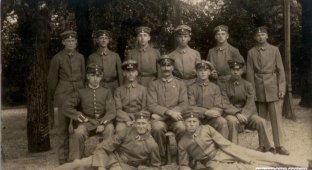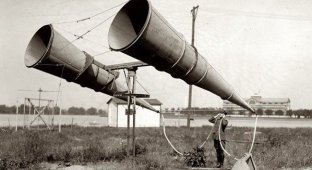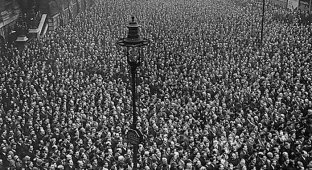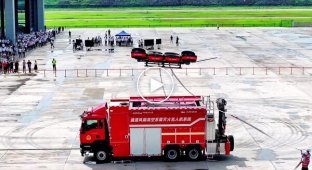Airship - sky ship, air house and combat unit of the First World War (27 photos)
Skyships, clouds of revenge, an airy house - these amazing devices were called as they were. Airships and balloons showed themselves most clearly during the First World War.

Shutte-Lanz SL2
During the war, the Zeppelin LZ-16, along with the Shutte-Lanz SL2 and Zeppelin ZV, were used on the Eastern Front.

Zeppelin LZ-16. They were the most widespread and advanced representatives of rigid-type airships. Total for the period 1899-1938. 119 zeppelins were built, designated LZ by the shipyard
Zeppelin LZ-16 made its first flight on March 14, 1913. On April 2, 1913, during a flight from Friedrichafen to Metz, Zeppelin LZ-16 was caught in a storm. The airship was blown into France by the wind.
Zeppelin LZ-16 took part in the bombing of Warsaw, Luka and railway stations. The Zeppelin LZ-16 was later removed from the front and used for crew training until September 1916.

Zeppelin over Berlin


HMA No9 (His Majesty's Airship No9) is the first British rigid airship.
HMA No9 remained an experimental ship, like the first Zeppelins in Germany. In 1916, HMA No9 could no longer compete with the Zeppelins - the lag was too large. No9 was used to test various techniques, including landing against a mooring mast.

Zeppelin LZ-13 "Hansa" (Germany)
Zeppelin LZ-13 "Hansa" was the first to carry out international passenger transportation - to Denmark and Sweden. In total, Zeppelin LZ-13 "Hansa" made 399 flights. He flew 44,437 km. Decommissioned in 1916.

Construction of Zeppelin



Parseval PL-18 - soft-type airship (Germany - Great Britain). During the First World War it was used for reconnaissance in the North Sea and patrolled the English Channel.

Coastal Class (Great Britain) - a soft-type airship, designed for patrolling the coastline and escorting ships

Astra-Torres AT-1 (France). Airships of this type entered service with the French navy.

Alsace (France)
Alsace is a soft type airship. Built by the French company Astra.
In 1915, the airship Alsace actively participated in bombing operations, supporting the army's advance in Champagne.
During a combat mission on October 2, 1915, the Alsace was shot down over enemy territory near Rethel, in northern France. The crew was captured.

Clement-Bayard "Dupuy de Lome" (France)
The first flight of the airship produced by the Clement-Bayard company took place on October 29, 1908. In 1910, Russia acquired an airship from Clement-Bayard, which in Russia received the name "Berkut".
Interestingly, the Clement-Bayard company, founded in 1903 by Gustaf Adolf Clement, produced cars under the Clement-Gladiator brand, which was later absorbed by Citroen.

Golden eagle. Russia
In 1910, Russia acquired four airships abroad: three in France - "Clément-Bayard" (in Russia called "Berkut"), Zodiac - VII and Zodiac - IX ("Kite" and "Seagull"), and one in Germany - Parceval PL-7, called "Vulture".
In the summer of 1916, the Berkut was dismantled.

Parseval PL-14 (Petrel) (Germany - Russia)
By the beginning of the First World War, Russia had 14 airships in service. In 1913, the Russian army acquired 3 large-capacity airships: Astra-Torres, Clément-Baillard in France and Parseval PL-14 in Germany. They received the names “Astra”, “Condor” and “Burevestnik” in Russia. Another Albatross suitable for combat was in service in Lida.
All four airships were armed with machine guns, had provisions for dropping bombs, and had a flight duration of up to twenty hours.

Airship "Giant" - 1915. Unfortunately, this is the only photo. The giant was built for the needs of the army and had no analogues in the world.
The length of the airship was 105 m, the maximum diameter was 16.25 m, the power of four engines was 600 hp. Estimated horizontal speed 65 km/h, maximum flight altitude 3500 m. Fuel reserve for 20 hours. During the first test, an accident occurred, the balloon was sent for revision, but by that time the airship was out of date. It never flew into the air again and was dismantled.

Airship "Swan", 1909 (Russia)

Russian airships - "Condor", "Chernomor", "Albatross", "Dove".

Nobile-Crocco SR.1 (Italy). Nobile-Crocco - semi-rigid bomber airship
A total of 22 M-series airships were built. Airships intended for the land front were equipped with light steel gondolas with two 220 hp engines. Airships intended for the navy were equipped with a heavier gondola with 200 hp engines.
3 or 4 machine guns with a caliber of 7.62 mm were installed in the cockpits of M-type airships. Sometimes a 37 mm caliber gun was installed. Starting with the M.9 airship, a weapons platform with one machine gun was equipped on the shell. Airships could lift up to 1000 kg of bombs to a height of 2000 m.

Crocco-Ricaldoni M.1 and M.2 (Italy) - semi-rigid airships
During the war, the M.1 was transferred to the Italian Navy. M.1. made 164 flights. After the war, the M.1 was renamed "Angelo Bernardi" and used for passenger transport. It made 54 missions and carried 800 passengers. Was decommissioned in 1920.

Forlanini F.5 (Italy)
The F.5 was built for the Italian army in 1917. Two Fiat S.76 A engines with 250 hp each. rotated one four-bladed propeller. The volume increased to 18,300 cubic meters. 25 March 1919 F.5 burned out in its hangar.

Observation balloons. Drachen (Germany)

Caquot. France

German balloon with a gondola for an observer in flight


























